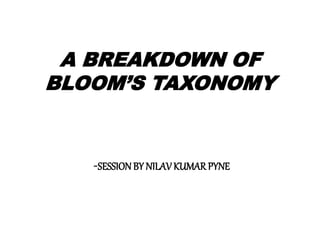
Breakdown of bloom's taxonomy
- 1. A BREAKDOWN OF BLOOM’S TAXONOMY -SESSIONBY NILAV KUMAR PYNE
- 2. • Do take notes wherever you find necessary. • Keep an open mind and not judge the facilitator on the facts/opinions he might state. • We are aiming at individual and group productivity throughout the session i.e. proper utilization of time and resource. • Do feel free to add value to the session. A FEW GENERIC RULES-
- 3. LET US FIRST BEGIN WITH A LONG THEMATIC CONNECTION QUESTION
- 4. • FIRST SLIDE - +40,-20 • SECOND SLIDE- +30,-10 • THIRD SLIDE -+20,-5 • FOURTH SLIDE-+10,0
- 9. ANSWER
- 10. OUR NATIONAL ANTHEM- JANA GANA MANA
- 11. Q. Which song was written on 11 December 1911 by Rabindranath Tagore and sung on 28 December 1911 at the Calcutta session of the Indian National Congress? It is exactly 52 seconds long.
- 12. JANA GANA MANA- OUR NATIONAL ANTHEM
- 14. • Q. How do you think the two questions in the DO NOW were different? • Q. Do you see implementation of Bloom’s levels in both the questions? • Q. How often do you apply the Bloom’s Levels theory in your lessons in the classroom? • Q. How much would you rate your class in terms of rigour and why?
- 15. • FWBAT differentiate skill and knowledge aspect of a lesson. • FWBAT analyze the model of Bloom’s taxonomy and design a rigour lesson using it. • FWBAT teach to the highest (thinking level), by scaffolding to the lowest (thinking level). TODAY’S SESSION BIG GOAL
- 16. • Knowledge(noun)-facts, information, and skills acquired through experience or education; the theoretical or practical understanding of a subject. • Synonym- understanding, comprehension • Skill(noun)- The ability to do something well; expertise • Synonym- adroitness, prowess, flair, virtuosity • Rigour(noun)- The quality of being extremely thorough and careful. • Synonym- meticulousness, attention to detail, scrupulousness, punctiliousness. WHAT OXFORD DICTIONARY SAYS-
- 17. • Fellows will understand the Bloom’s model and apply the knowledge to design their own lesson for the class. • Fellows will also analyze and evaluate the effectiveness of the model by executing their lesson in the class. HOW WOULD WE ACHIEVE TODAY’S OBJECTIVE
- 18. Thinking Levels Q. Highest and Lowest what? A. Thinking Levels. Introducing: HOT - Higher Order Thinking LOT – Lower Order Thinking
- 19. Bloom’s Level 1: KNOWLEDGE Associated Verb: Remember Remember? Remember! •What...? •Who...? •When...? •Where...? •How...? List Recall Name Label Identify /Recognize
- 20. Bloom’s Level 2: UNDERSTANDING Associated Verb: Comprehend Comprehend? Comprehend! •Can you write ... in your own words? •Can you explain the main idea? •Can you illustrate what you’ve learned with an example? Summarize Illustrate Explain Describe
- 21. Bloom’s Level 3: APPLICATION Associated Verb: Apply Apply? Apply! •Why...? •Can you solve...? •Can you use this information to...? Solve/Calculate Construct/Make Use
- 22. Bloom’s Level 4: ANALYSIS Associated Verb: Compare Compare? Compare! •How would you differentiate between...? •Can you classify the similar...? •What would you prioritize...? •How does the beginning compare with the end? Contrast Relate Prioritize Categorize
- 23. Bloom’s Level 5: EVALUATION Associated Verb: Justify Justify? Justify! •Is there a better solution to...? •Can you defend your opinion? •Can you prove...? •Can you predict an ending aligned to...? Support Debate Assess Conclude
- 24. Bloom’s Level 6: CREATION Associated Verb: Create Create? Create! •Can you design...? •Can you compose...? •What new and unusual solution can you suggest? Produce Develop Synthesize
- 25. Let’s test ourselves for the lowest of the LOTs. Q. What was the Big Goal for this session? FWBAT teach to the highest (thinking level), by scaffolding to the lowest (thinking level).
- 26. Objective SWBAT explore the use of a globe and a map, to study world geography. (This objective assumes some elementary knowledge about the world geography, on the part of the students)
- 27. Assessing LOTs Level 1: KNOWLEDGE Q. Which continent does the picture on the globe look like? Which continent does the picture on the map look like? Level 2: UNDERSTANDING Q. Do both pictures show the same continent? Explain with 3 reasons. Level 3: APPLICATION Q. Use the globe and the map to complete the table below:
- 28. Assessing HOTs Level 4: ANALYSIS Q. Use the table above to compare what you have learned about Africa from the globe and the map? Level 5: EVALUATION Q. ‘Two things that are equal to the same thing, are equal to each other.’ Prove this statement, using the example of a globe and a map to understand world geography. Level 6: CREATION Q. Using your knowledge of world geography, re-organize yourselves into 7 groups – for the seven continents – and arrange the classroom to represent the world map.
- 29. Observe that... • We have successfully integrated a concept of high learning level, by scaffolding it down to the lowest level. • We could create a differentiated assessment to test the same knowledge (about world history) and concept, by using Bloom’s. • It can hence be concluded, that Bloom’s, when used efficiently, can be used to assess high-level topics, with multi-level scaffolding to test all learning levels.
- 30. • Choose any object from your grade level text and design a rigour lesson using the model of Bloom’s taxonomy. • Your lesson should have a clear demarcation between the knowledge you are providing and the skill you are trying to build through the lesson. THE BALL IS IN YOUR COURT NOW
- 31. Finis.